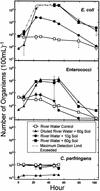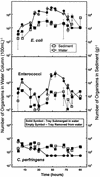Influence of soil on fecal indicator organisms in a tidally influenced subtropical environment
- PMID: 11872464
- PMCID: PMC123749
- DOI: 10.1128/AEM.68.3.1165-1172.2002
Influence of soil on fecal indicator organisms in a tidally influenced subtropical environment
Abstract
The potential regrowth of fecal indicator bacteria released into coastal environments in recreational water bodies has been of concern, especially in tropical and subtropical areas where the number of these bacteria can be artificially elevated beyond that from fecal impacts alone. The task of determining the factors that influence indicator bacterial regrowth was addressed though a series of field sampling and laboratory experiments using in situ densities of Escherichia coli, enterococci, and Clostridium perfringens in river water, sediment, and soil. Field sampling efforts included the collection of surface sediments along the cross section of a riverbank, a 20-cm-deep soil core, and additional surface soils from remote locations. In addition to field sampling, two types of laboratory experiments were conducted. The first experiment investigated the survival of bacteria already present in river water with the addition of sterile and unsterile sediment. The second experiment was designed to simulate the wetting and drying effects due to tidal cycles. The results from the sampling study found elevated numbers of E. coli and C. perfringens in surficial sediments along the riverbank near the edge of the water. C. perfringens was found in high numbers in the subsurface samples obtained from the soil core. Results from laboratory experiments revealed a significant amount of regrowth for enterococci and E. coli with the simulation of tides and addition of sterile sediment. Regrowth was not observed for C. perfringens. This study demonstrates the need to further evaluate the characteristics of indicator microbes within tropical and subtropical water systems where natural vegetation, soil embankments, and long-term sediment accumulation are present. In such areas, the use of traditional indicator microbes to regulate recreational uses of a water body may not be appropriate.
Figures







References
-
- Abbot, S., B. Caughley, and G. Scott. 1998. Evaluation of Enterolert for the enumeration of enterococci in the marine environment. N. Z. J. Mar. Freshw. Res. 32:505-513.
-
- American Public Health Association. 1995. Standard methods for the examination of water and wastewater, 19th ed. American Public Health Association, Inc., Washington, D.C.
-
- American Society for Testing and Materials. 1996. Standard test method for detection and enumeration of C. perfringens from water and extracted sediments by membrane filtration. American Society for Testing and Materials (ASTM) publication no. D 5916-96. American Society for Testing and Materials, West Conshohocken, Pa.
-
- Ashbolt, N. J., M. R. Dorsch, P. T. Cox, and B. Banens. 1997. Blooming E. coli, what do they mean?, p. 78-85. In D. Kay and C. Fricker (ed.), Coliforms and E. coli, problem or solution? The Royal Society of Chemistry, Cambridge, England.
-
- Bisson, J., and V. Cabelli. 1980. Clostridium perfringens as a water pollution indicator. J. Water Pollut. Control Fed. 52:241-248. - PubMed
Publication types
MeSH terms
Substances
LinkOut - more resources
Full Text Sources
Medical

